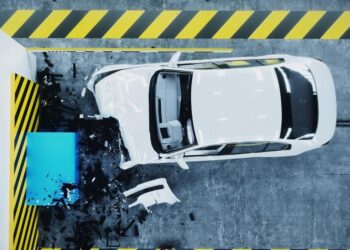These days, driving on California’s roadways can often seem like you are seriously risking your personal safety. Drivers speeding, weaving in and out of lanes, tailgating, driving at night without headlights are common occurrences. Even more serious instances of negligent driving involve drivers under the influence of alcohol or drugs. When drivers who care about safety witness such behaviors, they might be convinced that they are seeing examples of reckless driving. But are they?
Understanding the Distinction between Negligent & Reckless Driving
In California, two standards come into play when determining whether bad driving is simple negligence or whether it is reckless. All California drivers must exercise “reasonable care” in driving a vehicle to avoid harm to others. This includes, but is not limited to, keeping a lookout for other vehicles, pedestrians, and people operating other types of transportation, such as bicycles.[i] The failure to exercise reasonable care is considered to be negligence.[ii]
The reasonableness of one’s driving depends on the circumstances that exist at the time.[iii] For example, if the weather is clear and dry, and one is driving through a populated area with a posted speed limit of 35 mph, it may be perfectly reasonable to drive the speed limit. On the other hand, if the roads are wet or slick due to rain or snow, and visibility is poor, driving in that same area at the speed limit might not be reasonable. Under the circumstances presented in the second scenario, a reasonable driver might consider decreasing their speed, even though lower than the posted speed limit, so they are able to stop in time to avoid a collision.
Reckless driving is altogether different than simply driving a vehicle negligently. In California, “reckless driving” is defined in Vehicle Code section 23103, which states that “a person who drives a vehicle upon a highway in willful or wanton disregard for the safety of persons or property is guilty of reckless driving.” The statute goes on to specify that reckless driving is punishable as a crime.
The key to understanding the difference between negligent driving and reckless driving is in the statute’s use of the phrase “drives…in willful or wanton disregard for the safety of persons or property…” Unlike a failure to exercise “reasonable care,” “willful and wanton” is a legal phrase used to refer to actions that are conscious or intentional. If they do not rise to the level of intentionality, the actions must reflect an utter indifference to the lives and safety of others or their property. In other words, to be guilty of reckless driving, the driver must have a particularly culpable state of mind or care nothing about the harmful consequences the driver’s actions might cause others to suffer.
Put another way, a negligent driver may not mean for a collision to happen; whereas, a reckless driver either consciously behaves in a manner likely to cause a collision, or the driver simply does not care whether the actions cause a collision or not. Reckless drivers act in extreme ways that go beyond what ordinary people would consider being “bad driving.” Reckless drivers often cause extensive harm, including fatalities to others, or severely damage property. For this reason, in California as in most jurisdictions, reckless driving is a crime.
Examples of Negligent & Reckless Driving in California
Below are some examples of negligent driving juxtaposed with reckless driving:
Negligent Driving |
Reckless Driving |
|
Speeding |
Speeding 20 mph or more over the speed limit, particularly on a busy street or where pedestrians are present |
|
Failure to yield right of way |
Gunning vehicle through an intersection against red light as pedestrians are crossing the street |
|
Texting while driving |
Driving under the influence of alcohol or drugs |
|
Making an illegal U-turn |
Driving the wrong way down a one-way street |
|
Unsafe lane change |
Drag racing another vehicle |
|
Following a vehicle too closely |
Attempting to evade a police officer |
|
Unsafe left turn |
Passing a school bus that has red lights flashing |
It should be noted that the examples of negligent driving can rise to the level of reckless depending on the particular circumstances existing at the time of the collision, or if a driver exhibits more than one of these examples.
Pros & Cons of a Reckless Driving Personal Injury Claim
Pursuing a reckless driving personal injury claim can be a mixed blessing. On the one hand, the injured plaintiff will likely have an easier time proving the other driver’s fault to a jury because the conduct is so outrageous. Moreover, because the conduct is intentional, the plaintiff may also be able to obtain an award of punitive damages against the defendant in addition to money to compensate the plaintiff for medical expenses, lost income, and the like. On the other hand, if a defendant driver truly drives recklessly – and particularly if convicted of the crime of reckless driving – the plaintiff may find the at-fault driver’s insurance company denying insurance coverage for the collision, even when there is no dispute the reckless driving caused the plaintiff’s injuries.
Automobile insurance policies typically exclude coverage for bodily injuries or property damages that result from intentional misconduct. Some policies exclude specific types of reckless driving, such as drag racing or stunts. When seeking compensation for the plaintiff from a claims adjuster, the prudent attorney should try to de-emphasize the intentional nature of the defendant’s misconduct and attempt to persuade the adjuster that the misconduct was also negligent. This feat can sometimes be tricky to pull off in settlement negotiations.
At the same time, some insurance companies settle reckless driving claims more quickly than other automobile claims. These companies usually want to avoid the risk of going to a jury because a jury is likely to sympathize with the injured plaintiff and heap scorn on the reckless defendant. However, even in cases involving a risk-averse insurance company, the company will not pay punitive damages to the plaintiff. In fact, in California and many other jurisdictions, insurance companies are prohibited as a matter of public policy from insuring a policyholder against a claim for punitive damages. If a plaintiff wants punitive damages, the plaintiff will have to seek them from the defendant’s own pocket, and in many instances, the defendant may not have sufficient assets to pay punitive damages.
I Was Hit by A Drunk Driver & The Driver’s Insurance Paid
Some readers may have had the unfortunate experience of being injured as a result of an intoxicated driver. You may have filed a claim against the driver’s insurance company and received a settlement. You may be asking, why do insurance companies pay out on drunk driver cases if driving under the influence is considered reckless driving as well as a crime?
The first point to emphasize is some insurance companies will resist paying these claims, but most do not. The reason is because of the intoxicated driver’s lack of intent. An intoxicated driver may willfully decide to drive under the influence of alcohol or drugs. We can all imagine a scenario where an intoxicated driver refuses to let a friend drive him home from the bar after a bender. Perhaps, a driver purposefully continues drinking even though realizing he or she is intoxicated and knows he or she will have to drive home. These situations result in driving that is both reckless and criminal. However, the intoxicated driver did not necessarily intend to cause a collision or harm anyone. For this reason, insurance companies will usually pay these claims rather quickly.
[i] California Civil Jury Instructions (CACI) 700
[ii] California Civil Jury Instructions (CACI) 401
[iii] Watkins v. Ohman (1967) 251 Cal.App.2d 501, 502-503










